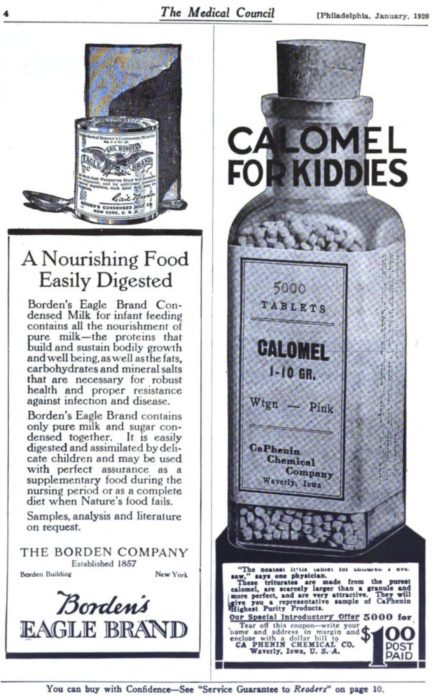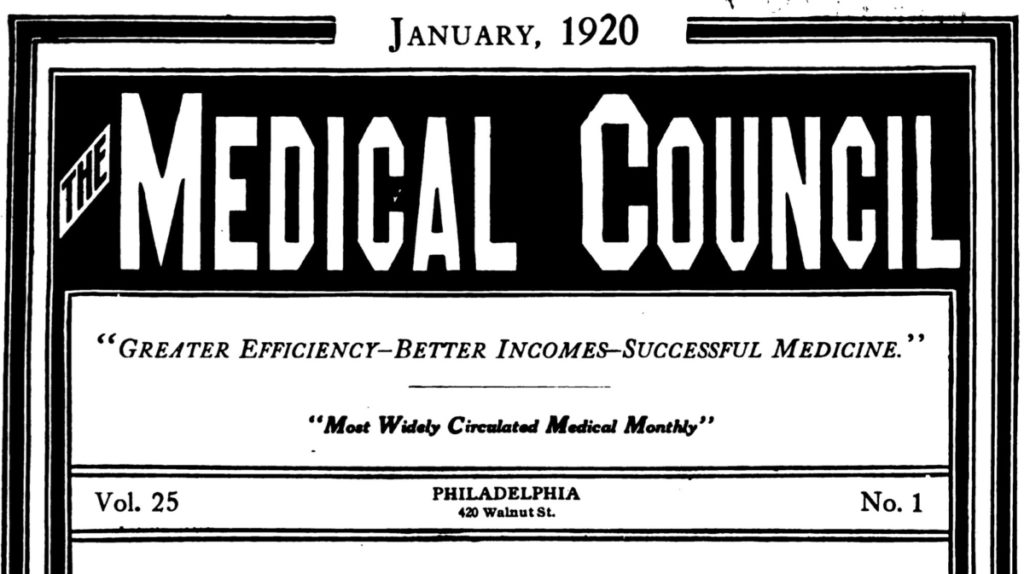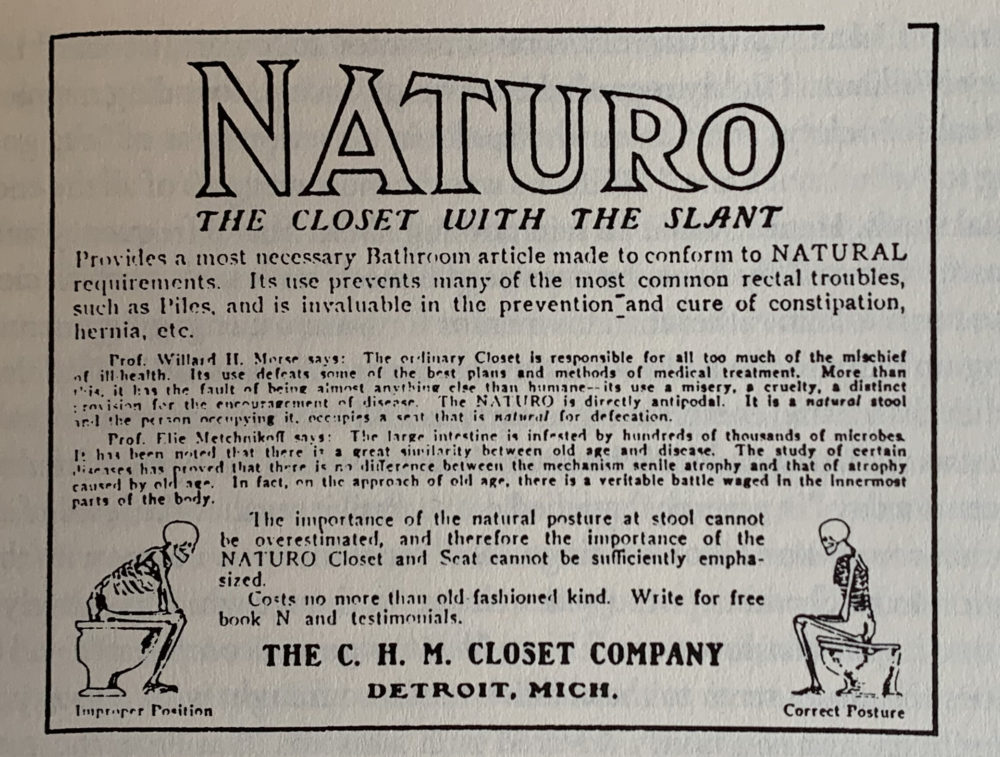Of fever high, or parts that swell—The remedy is calomel.

Physicians of the highest rank—To pay whose fees would need a bank—
Have pressed their science, art, and skill Into a dose of calomel.
Whate’er the patient may complain Of head, or heart, or nerve, or brain,
Of fever high, or parts that swell—The remedy is calomel.
When Mr. A. or B. is sick, “Go for the doctor; and be quick.”
The Doctor comes with right good will, And ne’er forgets his calomel.
He turns unto the patient’s wife, And asks for paper, spoon, and knife;
“I think your husband will do well To take a dose of calomel.”
He then deals out the fatal grain, “This, ma’am, will surely ease the pain,
Once in three hours, at chime of bell, Give him a dose of calomel.”
The man grows worse quite fast indeed, A council’s called. They ride with speed.
They crowd around his bed, and tell The man to take more calomel.
The man in death begins to groan, The fatal job for him is done.
His falt’ring voice in death doth tell His friends to shun all calomel.
Now, when I must yield up my breath, Pray let me die a natural death,
And bid you all the long farewell Without the use of calomel.“Calomel,” a mid-nineteenth-century song
Calomel: “Mild chloride of mercury, Hg2Cl2, a heavy, white or yellowish white substance, insoluble and tasteless, much used in medicine as a mercurial and purgative; mercurous chloride. It occurs native as the mineral horn quicksilver.”
I’d thought that it was not used much after the Civil War era but it is in fact in medical journals through the 1920s (like this ad).
As we discuss James Whorton’s history of health reformers, Crusaders for Fitness, keep in mind that the elite orthodox physicians of the era, engaged in proper science, were purging and bloodletting their patients for problems mild to severe. As this was a popular song about top-notch educated physicians, one might ask exactly who the “dolts” and quacks “without critical thinking” skills actually were.
In other words, why do we call NYU-educated (then Bellevue) physicians who recommended vegetarianism, fresh air and exercise quacks but Ivy-league bloodletters are considered respectable, critical thinkers?
Or, who creates knowledge? In this case professional and medical knowledge. Who decides what is objective fact?

Whorton’s 1982 history of American health reformers is such a classic in the field that no one has attempted another. It was reissued by the Princeton Legacy Library in 2016, but you can find a used copy for far less. Since 1982, Whorton has written a history of alternative health in the US (Crusaders often reads as a history of alt health) and a history of constipation (indeed. Our toilet stools are not new. Nothing is). He also taught a class on the history of alternative health to med students at UW.
This is a history of the crusaders themselves, an entertaining approach to understanding the cultural and scientific history of the era. As implied by “crusaders,” he emphasizes the religious zeal of the health reformers, which continued well beyond the (contested) introduction of the germ theory, when MDs engaged social gospel to justify and popularize physical education.
Though the health-reform crusades were “often naive and short-lived,” the reformers were too popular and well-educated, with “otherwise critical minds,” to toss them aside as Samuel Clemens (Mark Twain) did, as “the nuts among the berries” (3). Instead, he examines these “otherwise critical minds” to learn more about the social and intellectual causes that inspired the reforms’ widespread popularity. Rather than fads, these reforms were “hygienic ideologies, idea systems” that defined the “correct” personal hygiene as the very foundation of human progress. These systems of health were popular because they drew on “universal” sentiments about humans and nature while they also addressed the common anxieties and desires of their time.
Well that sounds familiar.

In his Varieties of Religious Experience (1902), alleged father of American psychology, William James, noted the religious zeal of the health reformers. James located the root of health-zeal psychology in the belief that “Nature, if you will only trust her sufficiently, is absolutely good.” This unquestioned trust in nature marked, for Whorton, all ideological health movements.
To follow this logic, if nature is good, “she” would not want us to suffer pain. Thus illness must be against nature’s laws and ill health is an evil brought about by violations of natural, physiological laws. (Physiology was the hot science of the 1830s and 1840s, when Whorton’s treatment begins.)
The strict Puritanism of early America was turned over in the 18th century for Arminianism, the belief that god wants everyone to be saved, but every individual is responsible for his own salvation. This squared nicely with America’s growing market economy. Whorton argues that Arminianism was embraced by health reformers. God (nature) wants everyone to be healthy and happy but s/he must earn it through pure living and avoidance of temptation and vice. By observing proper diet, dress, and activity, people could gain vital powers beyond those endorsed by science.

Yet health reformers embraced the scientific view of the brain’s molecular structure and taught that the brain was affected “by diet and observation of the mind-clearing, tension-relieving effects of strenuous exercise.” This “made it easy to suppose good hygiene must elevate mental ability” (5).
Can you imagine the quackery? Cal-o-mel. Cal-o-mel. (We’re reminded again of Wendy Suzuki’s work on exercise and mental clarity.)
Because the resulting mental improvement also increased will power, immoral choices were avoided as man would not give into his ravenous, sinful appetites. Ergo, good regimen improved one’s moral status as well as health. Physical and moral laws were intertwined and designed by god, and science was but a child of god.
Later the message was secularized and god removed. Reformers of the late 19th and early 20th century preached that the physical health of every individual, achieved through proper health habits, would bring about an ideal society. No need to look at the structural problems of society or the sheer impossibility that the lower classes can find the time or resources such healthy lifestyles required. Just get some sunlight and greens and society will “evolve.” Everyone can get some greens and sunlight! Breathe! No cost! Remind you of our youtube better-yourself proselytizers?

The moral hygienists found the city dirty and immoral, but they praised innovation and believed cities could be further improved by advancing technology. They did not believe the rural past was superior, though it was easier to stay healthy. Rather, man simply needed to avoid the vice, sloth, and indulgence the city made so available.

On the intelligence of reformers, Whorton ventures: “The mental stature of health reformers has been another matter entirely. They have not, as a rule, been the dolts of popular stereotype. But they have lacked the critical faculties needed to temper their congenital optimism….They have generally been well-read and progressive individuals, conscientious about staying abreast of developing science, but unable to recognize any implications of that science running contrary to their fundamental faith in human perfectibility” (8).
While they were not “dolts,” they weren’t too discerning, either. What Whorton elides here is that most of these reformers were scientists or MDs who were no more or less biased, optimistic, or enthusiastic than the scientists and MDs of today. (Have you heard? Dying is an illness and if you live right, with tons of expensive supplements, total control over your schedule, and some plastic surgery, you will evade it.)
To simply chuckle at these “quacks” along with Whorton (though it’s meant to be a balanced treatment) almost two hundred years later is ahistorical at best. Recall that “regular,” “orthodox” MDs of the day used mercury (calomel) and bloodletting as regular treatments.
As if I would let you forget.
If you’d like to support the site, buy stuff that you need from the links. Some of them send us kickbacks at no cost to you, but a wee cost to the empire. Or buy nothing and give your favorite grad student a tip.
 In honor of Whorton’s history of constipation, let’s talk about your toilet. Are you squatting on it? No? If a squat toilet isn’t part of your design scheme, bring the floor to you.
In honor of Whorton’s history of constipation, let’s talk about your toilet. Are you squatting on it? No? If a squat toilet isn’t part of your design scheme, bring the floor to you.
This model is bamboo and comes with a fabulous foot massager, but be aware a chunk broke off and lodged in my heel and, well, I bloodlet. (Leech therapy is coming back, did you know? Have a bad back?) Squatty Potty, the classic, is better made. They also come in white plastic and mod ottoman design, which does blend better with most decors. As such, it’s the one I gift.
chunk broke off and lodged in my heel and, well, I bloodlet. (Leech therapy is coming back, did you know? Have a bad back?) Squatty Potty, the classic, is better made. They also come in white plastic and mod ottoman design, which does blend better with most decors. As such, it’s the one I gift.
You think you don’t need this? That’s what a (long-time) client’s husband said when I gave one to his wife as a gift. Within a week he’d ordered several, one for all of their bathrooms. For real.

In the early 20th century, the C.M.H. Closet Company designed toilets to slant down in the back, as above.
You know. It’s natural.
Christoph-Daniel Hohmann et al., “The Effectiveness of Leech Therapy in Chronic Low Back Pain,” Dtsch Arztebl International 115, no. 47 (November 23, 2018): 785–92.